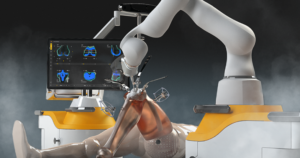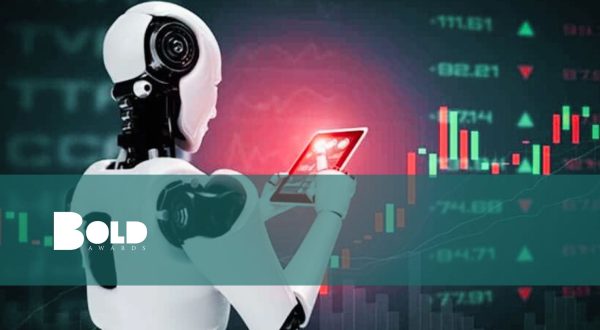The word “robot” invariably conjures up images of humanoid machines reminiscent of science fiction. However, today’s reality goes far beyond these depictions. Robotics and automation are transforming industries, revolutionising healthcare, and even reshaping the way we live and work. Here is a look at the world of robotics, both the current trends and a glimpse at what’s next on the horizon.
1. The Rise of Collaborative Robots (Cobots)
One of the most notable trends in robotics is the emergence of collaborative robots, or cobots. Unlike traditional industrial robots that are often kept behind safety barriers, cobots are designed to work alongside humans. They are equipped with advanced sensors and safety features, making them ideal for tasks that require close human-robot interaction.
 Alongside private firms, NASA is developing cobots to accompany human astronauts. The Sample Acquisition, Morphology Filtering, and Probing of the Lunar Regolith (SAMPLR) robotic arm, which received a US$5 million NASA contract in February 2020, will be used to investigate the moon and learn more about its geotechnical characteristics. NASA will use what it learns on the Moon to prepare for the next giant leap – sending astronauts to Mars.
Alongside private firms, NASA is developing cobots to accompany human astronauts. The Sample Acquisition, Morphology Filtering, and Probing of the Lunar Regolith (SAMPLR) robotic arm, which received a US$5 million NASA contract in February 2020, will be used to investigate the moon and learn more about its geotechnical characteristics. NASA will use what it learns on the Moon to prepare for the next giant leap – sending astronauts to Mars.
In 2023 US healthtech company Monogram Orthopaedics held a live demonstration where a Monogram robot successfully operated on a cadaver alongside a surgeon in front of a virtual audience of over 5,000 people. There’s more about this surgical robot company later.
We expect to see an expansion of cobot applications in various industries, from manufacturing and healthcare to logistics and agriculture. As cobot technology continues to improve, their versatility and adoption will increase.
2. Artificial Intelligence and Machine Learning Integration
Artificial intelligence (AI) and machine learning (ML) have become integral components of modern robotics. These technologies empower robots to learn from their experiences, adapt to new situations, and make decisions autonomously. As AI and ML algorithms become more sophisticated, robots are becoming smarter and more capable.
The integration of AI and ML will lead to robots with enhanced perception, problem-solving abilities, and natural language processing, making them even more valuable in complex tasks and customer service roles.
3. Robotic Process Automation (RPA)
Robotic Process Automation is transforming business operations by automating repetitive and rule-based tasks. RPA software robots can perform data entry, document processing, and other routine activities with remarkable speed and accuracy. This trend is revolutionizing industries such as finance, HR, and customer service.
RPA will continue to expand into new industries and automate increasingly complex processes. As a result, organizations will experience improved efficiency and cost savings.
4. Robotics in Healthcare
Robots are playing a crucial role in the healthcare sector. Surgical robots assist surgeons with precision and dexterity, while robotic exoskeletons aid in rehabilitation and mobility enhancement. Telemedicine robots are facilitating remote patient care, especially in times when physical distancing is essential.

By May 2023, US medtech startup Monogram Orthopaedics had grown from gaining 22,000 investors through equity crowdfunding to its arrival on the stock market through an IPO. It made history in March 2023 by completing the first fully-remote robotic orthopaedic surgery in a live telecast. By 2027, 50% of all knee replacements will be robotic, up from just 12% today.
Healthcare robotics will continue to advance further, enabling minimally invasive surgeries, personalized treatments, and improved patient outcomes. Telemedicine robots will continue to bridge geographical gaps in healthcare access.
5. Autonomous Vehicles and Drones
Autonomous vehicles, including self-driving cars, trucks, and drones, are changing the way we transport goods and people. These robots rely on sensors, cameras, and AI algorithms to navigate, reducing the risk of accidents and improving transportation efficiency.

However, safety issues are still paramount. In San Francisco, a driverless taxi drove in to fresh concrete that had just been laid on a road. Following further, more serious incidents, California regulators have suspended the licence of the self-driving taxi service Cruise after ruling that its autonomous cars pose a danger to the public. It also said that Cruise, a division of General Motors, had misrepresented “information related to safety of the autonomous technology of its vehicles.” A competitive self-driving taxi company operating in San Francisco, the Alphabet-owned Waymo, is unaffected, and Cruise continues to operate in Phoenix, Austin and Houston.
It’s clear that autonomous vehicles will become more widespread, ultimately leading to safer roads and reduced traffic congestion. In the meantime, one of the biggest challenges is anticipating all the “what ifs” that face the introduction of robotics and automation.
Drones will find new applications, from delivery services to environmental monitoring and disaster relief. A McKinsey report stated “Drone technology has the potential to meet a range of last-mile consumer use cases, such as prepared food, convenience products, and other small packages, as well as B2B needs, such as moving medical samples to labs.”
Beyond deliveries of tangible items to end-users, drones are increasingly used in agritech to survey farmland and deliver nutrients or pesticides in a more targetted and sustainable fashion, reducing farmers’ costs and improving yields.
Sadly, there is also a growing list of conflicts around the world providing examples of drone warfare.
6. Ethical and Regulatory Considerations
As robotics and automation advance, ethical and regulatory questions arise. Concerns about job displacement, data privacy, and robot behavior in various contexts require careful consideration and regulation to ensure that robotics and automation benefit society while mitigating potential risks.
Machines have made jobs obsolete for centuries, and the Covid pandemic accelerated the trend to using robots. Temporary disruption to workers’ incomes became permanent for many when they were replaced by robots and they were left unemployed. On a more positive note, automation and artificial intelligence can free humans from dangerous or boring tasks. However, as automation and robotics let many types of companies do more with fewer people, the companies simply don’t need as many workers. Non-union workers are especially vulnerable. Government response varies, though in what could be taken as acknowledgment of unemployment’s wider cost to society, Swedish employers pay into private funds that help workers get retrained. Singapore’s SkillsFuture program reimburses citizens up to 500 Singapore dollars (about $362 in U.S. currency) for approved retraining courses.
Ethical and regulatory frameworks will evolve to address these challenges created by the greater use of robotics. As an example, the UK’s Law Commission (which keeps the law of England and Wales under review and recommends reform where it is needed) has recommended that a Regulator should be established to determine fault in the event of a collision involving an autonomous vehicle. The Regulator could be given powers to apply sanctions such as fines or Compliance Orders to the manufacturer in the event of a fault with the system design. It’s not encouraging that California regulators decided that the Cruise driverless taxi operator, a division of General Motors, had misrepresented “information related to safety of the autonomous technology of its vehicles.”
Conclusion
The world of robotics and automation is a dynamic landscape of innovation and change. From collaborative robots working alongside humans to the integration of AI and ML, the future of robotics promises to be transformative. Whether in industries, healthcare, or transportation, robots are set to make our lives more efficient, safer, and convenient. As we unveil the future of robotics, it’s essential to stay informed and be part of the exciting journey that lies ahead.
Be at the BOLD Awards Gala Dinner Ceremony
 Entries have closed and the finalists have been shortlisted for the 2024 BOLD Awards. Applications are open for you to request an invitation to attend the award ceremony on March 22nd, 2024, in Venice, Italy. It is a truly unique networking opportunity to meet international award winners and finalists in 33 categories of digital industries and the technology that powers them. Further details and how to apply are at https://bold-awards.com/request-an-invitation-for-bold-v/ #beBOLD
Entries have closed and the finalists have been shortlisted for the 2024 BOLD Awards. Applications are open for you to request an invitation to attend the award ceremony on March 22nd, 2024, in Venice, Italy. It is a truly unique networking opportunity to meet international award winners and finalists in 33 categories of digital industries and the technology that powers them. Further details and how to apply are at https://bold-awards.com/request-an-invitation-for-bold-v/ #beBOLD






